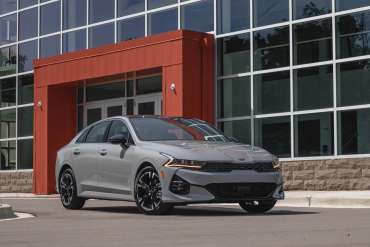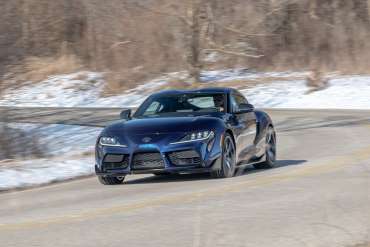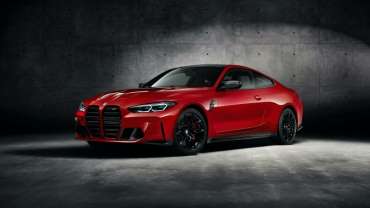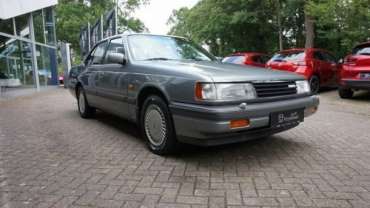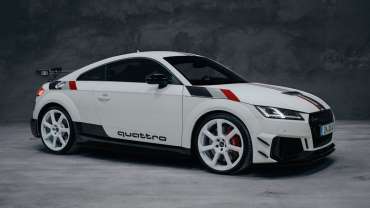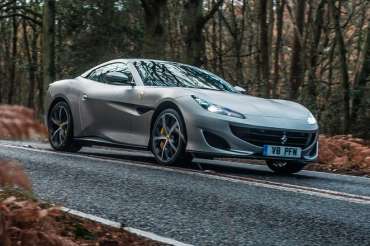
Worldcarblog.com
Tested: 2021 Kia K5 GT-Line Draws Closer to Excellence
With striking style and an upscale interior, Kia's new mid-size sedan is some chassis refinement away from rivaling the leaders in its class.
Children don't sketch SUVs in study hall and car designers don't spend years in school working their way up to studio boss to figure out how to draw a grille and headlights on a potato. The designers we know dream of penning performance cars, and while the 2021 Kia K5 isn't exactly that, it definitely looks like one.
"Longer and lower with a wider track" sounds like a Chevy ad from the '50s, but those descriptors belong to Kia's mid-size sedan, too. Compared with the Optima it replaces, the K5 measures two inches longer and nearly an inch lower and has an extra 0.8 inch between the tires. The proportions and design yield a striking car that belies its front-drive layout, the $24,455 starting price. We drove a GT-Line model with an asking price of $27,955, but a mechanically identical EX went to the test track and that's where the numbers came from. Aesthetes who find the Honda Accord and Toyota Camry too common might not turn their noses up at the K5.
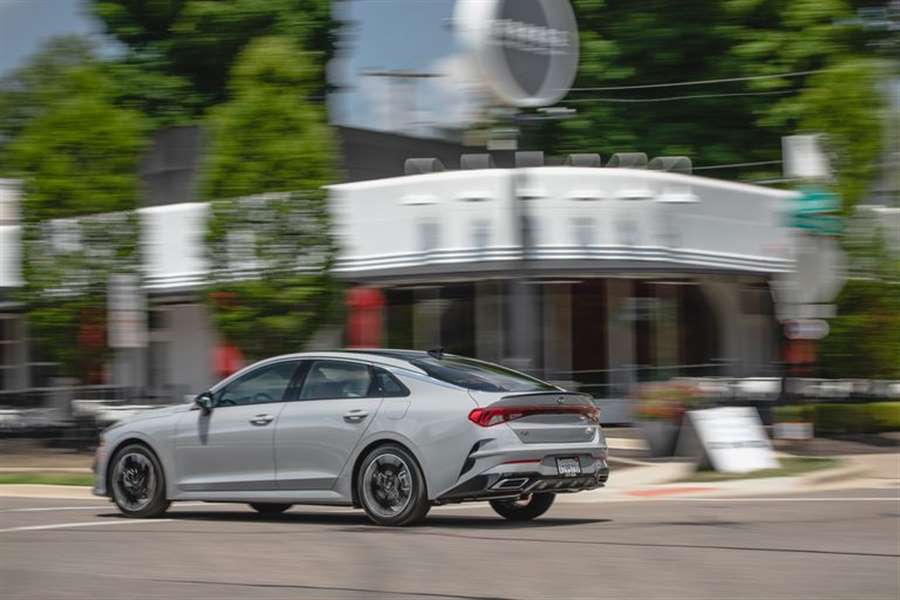
While the styling pleases eyes, the K5 is satisfying in many other ways. The base engine is a 180-hp turbocharged 1.6-liter four shared with the Sonata, and it's paired to an eight-speed automatic—no rubber-band CVT here. Shifts are smooth and quick, and the right gears are called up without any fuss. Low-end torque feels more abundant than its peak of 195 pound-feet at 1500 rpm indicates, and the turbo makes itself felt right away. Stomp it and the K5 gets to 60 in 7.0 seconds.
Venture beyond 5000 rpm and the engine moans, something you won't hear in an Accord. Driven more sedately, the K5 hums 67 decibels of sound into the cabin at 70 mph. All GT-Line and EX models have the same suspension tuning as the base K5, but they use 18-inch wheels with wider Pirelli all-season tires than the entry trim's 16s. Sharp impacts expose a lack of isolation. While not a deal breaker, it's worth noting that an Accord sops up the same hits with less coarseness. It's likely the shorter sidewalls of the 18-inch wheels and the one-size-fits-all tuning are to blame. The steering is both unerringly stable at highway speeds and deft and responsive when you're sawing through a canyon road or interesting on-ramp.
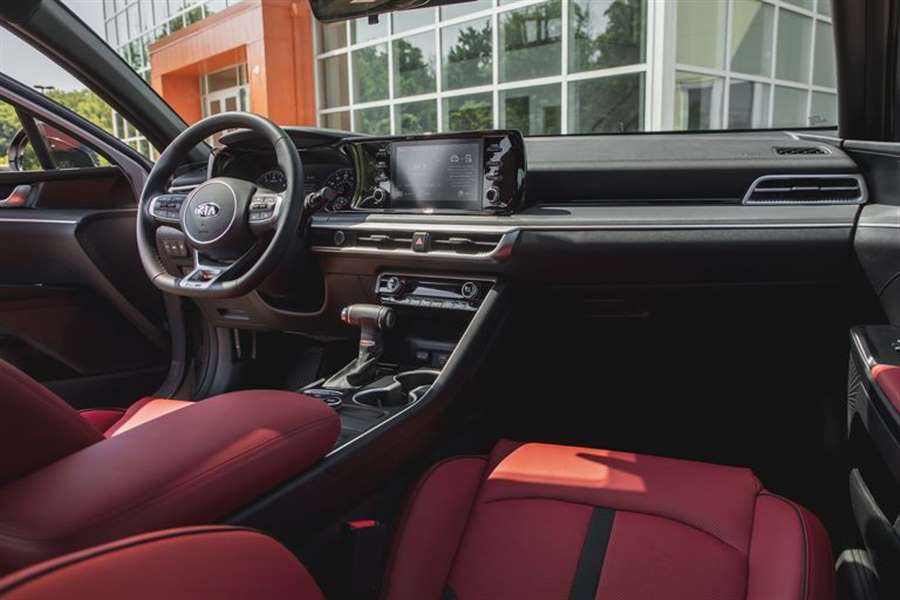
A radically angled windshield lends a sports-car mood to the driving experience, and the seating position is excellent. Rear-seat space is generous and comfortable. A 10.3-inch touchscreen is available on some trim levels, but the GT-Line comes with an 8.0-inch screen. Both sprout out of the dash and are flanked by physical buttons that make switching between functions easy. The instrument panel has a BMW-ness to it, and material quality throughout the cabin is good. Apple and Android phone mirroring is wireless on all models with the standard 8.0-inch infotainment screen, but strangely, you'll need a cable if you upgrade to the 10.3-incher.
The K5 inches closer to the Accord's ability to deliver everyday joy. A bit of suspension tuning to increase isolation and refinement would give it the manners to match its designer looks.
Source: caranddriver.com
Our 2020 Toyota Supra 3.0 Wows Wherever It Goes (PHOTOS)
Toyota's sexy sports car proves it has the presence to match its thrilling performance.
We've been driving our Toyota Supra 3.0 for eight months and 10,811 miles, and in that time we've learned something about it that no amount of track testing or comparison test battles could have predicted: that it would have instant street cred. For many people, our Downshift Blue Supra was the first they'd ever seen—Toyota has sold only 3798 through September—and it continually draws admiring looks, lustful glances, and a steady stream of "oohs" and "what's that?" In the court of public opinion, it's one killer sports car. We couldn't agree more.
Manufacturers build cars like the Supra in part to cast a halo over the rest of their lineup—they're actually called halo cars in industry parlance—and to burnish the reputation of the parent company that makes them. The Supra is doing exactly that. As Exhibit A, we offer some observations that our staffers have penned in the Supra's logbook.
"A man in a Honda Fit followed me to a Jimmy John's drive-through," wrote staff editor Austin Irwin, "parked, and walked over and asked to take a photo of the car. Another guy flagged me down at a Taco Bell to tell me his brother had a Supra from the 1990s." (Eating a lot of fast food these days, Austin?—Ed.) Then there was the robotics engineer who circled the Supra in yet another parking lot and exclaimed, "You bastards. You got the new Supra. Seeing this car, I'm going to buy one."
After driving the Supra for a two-week span, editorial operations manager Juli Burke reported, "I got a lot of long, longing looks from car fans." Print director Eric Tingwall observed, "This car attracts constant attention from males ages eight to 40. They all know it's a Toyota Supra, they think it's cool, and those who are aware that BMW builds it could not care less about its origins." He added, "The Supra appears to be rehabbing Toyota's beige reputation far more successfully than the Scion FR-S/Toyota 86. This is a halo car doing exactly what halo cars are supposed to do."
Indeed, what the citizenry inferred from the Supra's muscle-bound sheetmetal is exactly what it's been delivering from behind the wheel. We've already reported on its ripping performance—60 mph in 3.7 seconds and 1.05 g of skidpad grip. Speed and handling would never be an issue; what we wanted to know was what it was like to live with.
So far, so good. Our first 10,000 miles were accumulated virtually all within Michigan's borders thanks to COVID-19 concerns. But ours is a big state, and our drivers crisscrossed it multiple times visiting the burgs of Gaylord, Oscoda, South Haven, and the famous Warren Dunes State Park in Sawyer. We used it for weekend getaways as well as for daily commutes and grocery-store runs.
But nothing we did with it dulled its shine. Our admiration starts with the BMW-sourced turbocharged 3.0-liter inline-six, which propels our 2020 model like it has more than the claimed 335 horses. The 2021 models receive a bump to 382 horsepower. And we confirmed our car's status as an overachiever with a chassis dynamometer test. "I hope BMW charged Toyota a lot of money for this engine," said director of vehicle testing Dave VanderWerp, "because it's one of the greats." Assistant technical editor Max Mortimer added, "I love how rowdy and pure the exhaust note is." Nail the throttle at 10 mph and the Supra lights up its rear tires, the engine lunges for the 7000-rpm redline, and the exhaust blats out the howl of a thousand angry bloodhounds.
But hit the highway and the Supra settles down to a civilized cruise. "It did surprisingly well on a 600-mile weekend road trip," said VanderWerp. "Highway ride is very reasonable, and the tires only get really noisy over the rare concrete sections." Irwin added: "I love the seating position, low like a race car but within reach of the controls. Drive anything else after a week in the Supra, and you'll feel like a substitute bus driver."
On longer trips, the Supra surprised us with how parsimonious it was with fuel. During VanderWerp's weekend getaway to Michigan's northern regions, he noted, "Even when cruising at 80 mph, the trip computer was showing 35 mpg. Amazing." And despite our heavy-footed treatment in local driving, the Supra's average fuel economy to date is 24 mpg.
Inevitably, spending months with any car brings its weak points into focus, and the Supra has several. There has been no agreement on seat comfort. Our tallest driver liked the leather-covered buckets just fine, while an average-sized driver complained of the fit. But both agreed that the Supra's sexy styling, with its low roof and slits for windows, hurt visibility to all sides and made traffic lights hard to see without scrunching down in the seat. Its down-low proportions had even our youngest and most limber staffers complaining about how awkward it is to climb in and out of.
And don't even try to drive it with the windows down. Something about the Supra's bulging shape creates buffeting inside the cabin so vicious that by 55 mph your left hand involuntarily reaches for the window switches. "Heartbreaking," Irwin said. "I want to hear all of the exhaust sound and feel the wind rush." We'd also like more interior storage space, an exterior release button for the rear hatch, and a fuel gauge with markings that are easier to decipher. But really, everyone who cites a complaint about the Supra ends up saying how much they like it nonetheless.
We started this test wondering if a car jointly developed by two companies with very different engineering philosophies would introduce reliability issues that neither would have had if they built the car alone. If the first 10,000 miles are any indication, the answer is no. The Supra's service record has been as impeccable as we'd hope for if it were a Camry. It just received its first required service, an oil-and-filter change and a multipoint inspection, that cost $210. Beyond that, it has spent zero time at the dealer for unscheduled maintenance.
We couldn't be happier with it as we continue to pile on the miles. Time stuck in the shop means less time on the road. And no one around here wants to miss a chance to wrap their hands around the Supra's steering wheel and revel in its straight-six's joyful shouts.
Introduction
We are not putting the new Toyota Supra though a 40,000-mile long-term test to explore how we feel about it. We already know that it's quite good and that we like it a lot. To see how deep our respect for this killer two-seater goes, just follow the editorial breadcrumbs that we've dropped over the past year or so.
We heaped praise on the Supra the first time we drove it. We thought it was hot enough to pit against the BMW M2, Ford Mustang Shelby GT350, and Porsche 718 Cayman in a comparison test—and then against a BMW Z4 roadster in another shootout. It was so quick in our testing that we strapped it to a chassis dyno to verify its horsepower rating, which turned out to be more than Toyota claimed. We pushed it to the limit in our 2019 Lightning Lap track event, where it impressed. And then we gave it a 10Best award, the highest honor we can bestow on a new vehicle. Now we're filling in the missing part of the picture: how this brilliant sports car holds up to the daily grind.
There's a reason for our heightened curiosity about the Supra's long-term dependability. Toyotas have a reputation for being impossible to kill, but this is not your average Toyota. It's a mixed breed—part BMW, part Toyota. Toyota leveraged BMW on the Supra project, borrowing what it could from the Z4, much to the dismay of committed fanboys of previous-generation Supras, who wanted the new one to again be pure Toyota.
Whenever two companies with two different engineering cultures attempt to integrate their components and technologies, the door opens to potential glitches. Would this joint-venture car start showing issues somewhere down the figurative and literal road? That's what we're going to find out.
Mechanically, the Supra is more BMW than Toyota. Okay, maybe it's all BMW. Its turbocharged B58 3.0-liter inline-six, ZF eight-speed automatic transmission, electronically controlled limited-slip differential, steering rack, and suspension components are from BMW—the same basic pieces employed in the Z4 M40i. For 2020, Supras are fitted with a 335-hp version of the B58 inline-six, while the Z4 M40i launched with 382 horsepower. For 2021, Supras will get that higher-output engine tune as well.
Inside the Supra's tomb-dark cabin, you'll find more BMW gear, including the German company's electronic shifter, infotainment controls, and audio switches. Toyota was responsible for the Supra's exterior and interior design, the engineering of its body shell, and how its ride and handling was tuned. But the biggest difference between the two cars is that the Supra is a hatchback and the Z4 only comes as a convertible.
Our Downshift Blue Supra is the mid-grade GR (Gazoo Racing) 3.0 Premium model. Thanks to a full helping of standard comfort and convenience features, it's as much a grand tourer as it is a sports car. Its goodies include heated, 14-way power-adjustable seats covered in black leather; a head-up display; an 8.8-inch touchscreen infotainment system with navigation; automatic climate control; and a 12-speaker JBL audio system. Pre-collision automatic braking with pedestrian detection and lane-keeping assist are standard. To that we added just one major option: the Driver Assist package, which brings adaptive cruise control, blind-spot monitoring, and rear cross-traffic alert with emergency braking. A carpeted rear cargo mat and wheel locks brought the $54,945 base price to $56,285.
When our car arrived in mid-February, we attempted to fit it with a set of winter tires. It was virtually impossible to find a single source that could provide a matched set of high-performance winters in the Supra's size—255/35R-19 in front, 275/35R-19 at the rear. Enter Pirelli, who graciously pulled together a special set of Sottozero Serie II's for us in the correct sizes. "These are the most performance-oriented, street-legal winter tires available," Pirelli claims. Indeed, the fronts are designed for the Lamborghini Aventador, while the rears are intended for the Aston Martin DB9. Who drives their Lambo or Aston in the snow? We want to meet these people. We ultimately found that, between Tire Rack and Summit Racing, you could piece together a similar set for $1350.
Once set up with the proper footwear for foul midwestern winter weather, we eased the Supra through its 1200-mile break-in period, during which time engine revs are supposed to be kept below 4500 rpm and the vehicle below 100 mph—both surprisingly hard to do in a car this swift. With its factory Michelin Pilot Super Sport summer tires reinstalled for its initial outing at the test track, we once again witnessed performance that puts the Supra in the company of some serious high-performance machinery.
Our 3388-pound test car rocketed to 60 mph in just 3.7 seconds and through the quarter mile in 12.2 seconds at 113 mph. It circulated the skidpad at 1.05 g and stopped from 70 mph in 148 feet. Technical editor David Beard reported that it orbited the 300-foot skidpad with its rear end sliding as much as any car he's ever tested. We experienced the same tail-happy tendency in our previous tests, during flat-out laps at Virginia International Raceway (VIR), and on our favorite on-ramps on the winter tires. It's part of what makes the Supra feel exciting and on edge when driven hard. But as print director Eric Tingwall said of his laps in the car around VIR, "It can be a bit much." Toyota revised the Supra's suspension tuning for 2021, and we look forward to seeing if those changes make its rear end less prone to stepping out.
That particular behavior is something you'll only see when pushing the Supra to its limits. In normal driving, it's sweet, encouraging, and fun. It rides well enough to be a long-distance cruiser. It's agile enough to be fun anytime the road squirms. It's fast enough to make you laugh every time you nail the throttle. The BMW six-cylinder sounds fantastic. And its weird-science styling garners plenty of attention. In short, the Supra makes you feel good. Now we'll see if its maintenance requirements and day-to-day livability break that spell or enhance it.
Source: caranddriver.com
BMW M4 design study wears retro red (PHOTO)
The collaboration with N.Y. fashion house Kith is a one-off
BMW's M division has revealed a special 2021 M4 Competition coupe that is a collaboration with a New York-based fashion brand. The joint project with design house Kith has resulted in a unique M4 that is described as a design study.
The car is finished in Cinnabar Red, a factory color offering that was available on the original E30 M3. It was inspired by a Cinnabar Red E30 M3 belonging to Kith owner Ronnie Fieg. According to bmwblog, Fieg shipped his vintage M3 to Germany for a factory restoration. The work included custom elements featuring his company name on the roundels and badging.
The new M4 project is similarly co-branded. The M logo on the trunk lid is modified to read "Kith." The fashion company's name also appears on the custom seat upholstery. Aside from the custom design elements, the car appears to be a stock 2021 M4 Competition coupe. That means it's powered by an S58 twin-turbo straight-six making a mighty 503 horsepower and 479 lb-ft of torque.
As such, this M4 literally is one powerful promotional vehicle for the fashion brand. It's also a one-off. Still, BMW's M division is said to be interested in special projects with artists, so we could see more design collaborations involving M cars in the future.
Source: autoblog.com
Rare Rides: The 1990 Mazda 929, a Traditional Japanese Luxury Sedan
Today marks the second time a Mazda 929 will grace us here at Rare Rides. Late last year we featured the successor to today’s car, a pristine 929 from 1992. That smooth sedan had frameless windows, rounded shapes everywhere, and was designed specifically with the North American market and Lexus customers in mind.
Let’s take a look a the much more conservative luxury sedan Mazda designed before Lexus existed.
The car North America called 929 was known in its home market as Luce. Dating back to its debut in 1967, the Luce was Mazda’s flagship. A smaller manufacturer, Mazda did not field a full-size sedan for some time. Available in coupe, sedan, and wagon formats, the Luce remained mid-size through the ’77 model year. For ’78 the LA4 series Luce grew into a larger executive car, leaving the midsize segment to the Capella (626). In its new larger form the Luce coupe went away, and the model’s three-body lineup was maintained via a standard sedan, hardtop sedan, and a wagon. The market segment of the departed Luce coupe was filled from that point onward by the Cosmo.
The LA4 generation didn’t last for long and was replaced by the HB for 1982. Once more the Luce grew in size. Reflecting future trends early, there was no more wagon in the HB generation, only a sedan and hardtop. The hardtop HB had a very interesting front end treatment, by the way. HB had a good run and remained in production through 1986. The Cosmo continued on the HB platform through the rest of the Eighties, and HB was the last time the two cars shared underpinnings.
For model year ’87, HB became HC, and the Luce experienced another growth spurt. Again available in sedan and hardtop guises, the Luce/929 was sold in two sizes. Hardtop versions were longer and wider, at 194 inches and 67.9 inches, respectively. Standard sedans were 184 inches long, and 66.7 inches wide. Though traditional in its form, Mazda saw fit to offer a zesty Wankel engine in addition to standard I4 and V6 power. Inline-fours were of 2.0- or 2.2-liter guises. There was also a tiny 2.0-liter V6, and (in North American examples) a 3.0-liter V6. Notably, the J-series engine was the first V6 Mazda produced. The rotary option was a 13B, a twin-rotor 1.3-liter mill which was not offered in North America. Some Luce trims were in fact more luxurious than the 929 offered in America, as Mazda reserved its rotary power, adjustable suspension, and console refrigerator for the home market.
Mazda saw fit to import only the sedan to North America, feeling no need to come with hardtop length. Canadians had more options than Americans eh, as they received a standard Winter Package on their 929s. That meant a tougher alternator, winter tires, wipers that didn’t hide themselves under the hood, and heated seats. The vast majority of North American 929s were automatic, but a five-speed manual was theoretically available.
The most notable change in the 929’s timeline on these shores was the addition of the S trim for 1990. The 18-valve SOHC engine was upgraded to DOHC, and 24 valves. Performance and fuel economy both increased with this upgrade; horsepower jumped from 158 to 190. S also added two-tone paint and excellent lace alloys.
The 929 was too dated, too traditional, and a slow seller. Mazda got the most mileage out of its new V6 in North America via the very interesting rear-drive MPV. The 929 was replaced with the previously featured generation in 1992. Worth noting, Koreans absolutely loved the HC 929. Once Mazda stopped building it, they sold the design to Kia. Kia did a light front and rear rework and sold it as the Potentia from 1992 until 2001. The 929-cum-Potentia’s base 2.0-liter engine also saw use in the first generation Kia Sportage for many years.
Today’s Rare Ride is located in Germany because Americans can’t take good pictures when they have a 929 for sale. This V6 asks $10,500.
Source: thetruthaboutcars.com
Audi TT RS 40 Years of Quattro gets ferocious body work and retro stripes
To celebrate the 40th anniversary of its all-wheel-drive system, Audi has created a special edition of the Audi TT RS. And it's appropriately, if not imaginatively, called the TT RS 40 Years of Quattro (or 40 Jahre Quattro in the original German). It takes the already extreme sports coupe and adds wilder visuals and an extremely limited production run to make a very special car.
The most obvious change to the outside is the color scheme. The car and its wheels are painted white with red, black and silver hash marks, "Quattro" logos and black rocker panels that echo the Audi Quattro Coupe rally cars of the 1980s. A new hood vent, front splitter, front canards, side skirts, rear diffuser and larger rear wing add more visual punch and provide a bit more downforce.
The interior is spruced up with black leather and Alcantara with white stitching and some embroidery in the seatbacks. The shifter surround is painted to match the exterior. A rear seat delete option is available, which also adds a big carbon fiber chassis brace. This option reduces weight by 35 pounds and provides more chassis rigidity.
Mechanically, this TT RS is unchanged. It has the same turbocharged 2.5-liter five-cylinder that makes 394 horsepower and 354 pound-feet of torque. But it does drop its standard top-speed limiter, so now it can reach 174 mph.
In keeping with the "40" theme, only 40 examples of this TT RS will be built. They'll carry a high price, too, at 114,040 Euros, which converts to $133,649.
Source: autoblog.com
About WorldCarBlog.com
World Car Blog - Read the definitive new car reviews. Find your perfect new car by browsing our independent, informative and helpful car reviews.
If you want to publish your text on the site - contact us by email This email address is being protected from spambots. You need JavaScript enabled to view it.
Ferrari Portofino
As a rule of thumb, most cars that can be described as ‘entry-level’ feel a little low-rent compared to plusher models in the range. It’s fair to say, though, that the usual rules don’t apply where a certain Italian brand associated with a prancing horse is concerned. Indeed, the Ferrari Portofino is better thought of as an à la carte meal; intended to tempt customers new to the brand to return, picking something more expensive from the menu next time.
It’s also supposed to be a Ferrari that you can use every day, come rain or shine. Yes, the GTC4 Lusso fills that job description, too, but the Portofino is more compact, more economical (as if that really matters) and has a metal roof that can be lowered in a scant 14sec. There’s even a pair of rear seats and a boot that’s big enough for a couple of carry-on suitcases.
Under the heavily vented bonnet is a 3.9-litre twin-turbocharged V8 that produces a mighty 592bhp; that’s enough to give the Portofino a 0-62mph time of just 3.5sec and a toupee-destroying top speed of 199mph. Those are numbers that could embarrass many of Ferrari’s most expensive supercars just a few short years ago.
Of course, being a Ferrari, the asking price is rather stiff, and the Portofino faces stiff competition from the Aston Martin DB11 Volante, Bentley Continental GT and faster versions of the Porsche 911 Cabriolet. Should you be interested in any of these, or just need to buy your nanny a new runaround for dropping the kids off at school, don’t forget to check our New Car Buying service after you’ve perused our extensive review.
Source: whatcar.com

